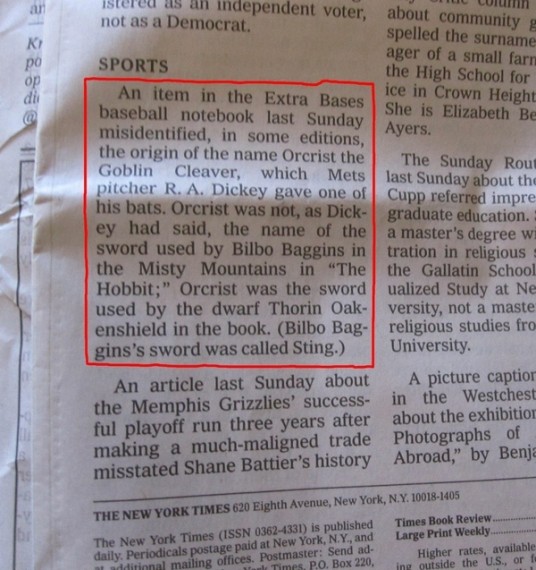Nerdiest Correction Ever
An item in the Extra Bases baseball notebook last Sunday misidentified, in some editions, the origin of the name Orcrist the Goblin Cleaver, which Mets pitcher R. A. Dickey gave one of his bats. Orcrist was not, as Dickey had said, the name of the sword used by Bilbo Baggins in the Misty Mountains in "The Hobbit"; Orcrist was the sword used by the dwarf Thorin Oakenshield in the book. (Bilbo Baggins's sword was called Sting.)
My wife passes along this correction posted at the New York Times Baseball Blog:
An item in the Extra Bases baseball notebook last Sunday misidentified, in some editions, the origin of the name Orcrist the Goblin Cleaver, which Mets pitcher R. A. Dickey gave one of his bats. Orcrist was not, as Dickey had said, the name of the sword used by Bilbo Baggins in the Misty Mountains in “The Hobbit”; Orcrist was the sword used by the dwarf Thorin Oakenshield in the book. (Bilbo Baggins’s sword was called Sting.)
Both BuzzFeed‘s Dave Stopera, PJ Tatler‘s Bryan Preston, and the Baltimore Sun‘s Luke Broadwater call it “the nerdiest correction ever.” I’m hard pressed to disagree.
Gawker‘s Max Read ups the NYT for nerdiness.
Orcrist, as everyone knows, was Thorin Oakenshield’s sword. But it’s not the Times‘ fault! It’s the fault of Mets pitcher R.A. Dickey, who doesn’t even know the origin of his bats’ names.
[…]
For extra credit, note the typographical error in the print edition that was corrected for web! For extra-extra credit, note why “Orcrist the Goblin Cleaver” is not, technically, the name of Thorin Oakenshield’s sword.
For the record, despite having read the books in question, I haven’t a clue.


Is it because “Orcrist” means “Goblin Cleaver”?
Orcrist means “goblin cleaver” in Sindarin, an Elven language.
D’oh. PD beat me to it. Let us retire to the nerdery!
That’s awesome.
“(text);” “(text)”;
My day is over time, to spark up.
AGHHHHH@%!&%!?
That is wonderfully redundant to call it Orcrist The Goblin Cleaver, but then again, Legolas Greenleaf is equally redundant as that is also just a translation. Also, the name Aragorn gets in Lothlorien, Elessar, the Elf-Stone, is also just a translation. Tolkien was nice about giving names in made up (very well crafted) languages, and then providing a translation.
They still didn’t get the correction right. I was so upset I wrote this open letter on my website:
http://www.isleyunruh.com/?p=4519
I hope the New York Times fixes this asap.
Layers of editorial oversight, indeed.
I’m guessing the typo Max Read refers to is the inclusion of the semicolon inside, rather than after, the quotation marks on “The Hobbit”. There’s a split among copyeditors over whether to put commas and periods inside or after the ending quote mark, but universal agreement that a semicolon comes after it.
Since we’re being LOTR nerdy. Tolkien once taught at the University of Kentucky. If you want to know where he got most of those Hobbit names, look in Louisville phonebook. Oh, and their principle export crop is …..?
You guys have WAY to much free time.
…and no mention of Glamdring or Ringil.
There’s a split among copyeditors over whether to put commas and periods inside or after the ending quote mark …
I didn’t know there was even a split: I was taught to put them inside the quote mark. But it doesn’t make sense in most cases, so I put it outside regardless of my training.
Oh, and their principle export crop is …..?
Pipe-weed…er, um, tobacco?
My nerd cred is completely shot. I saw the original, and thought that was sort of not right, but Orcrist was definitely the goblin cleaver so I let it go.
This correction may not disrupt the romance that the Mets writers have with Dickey the English major.